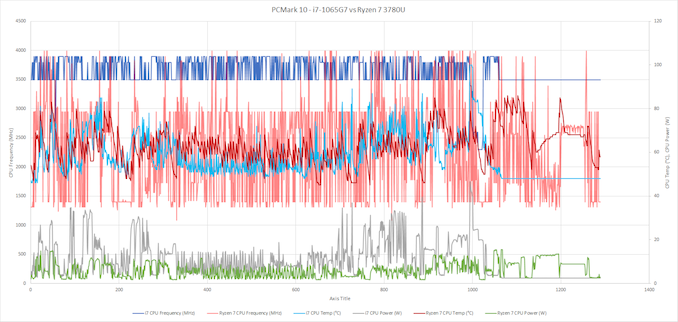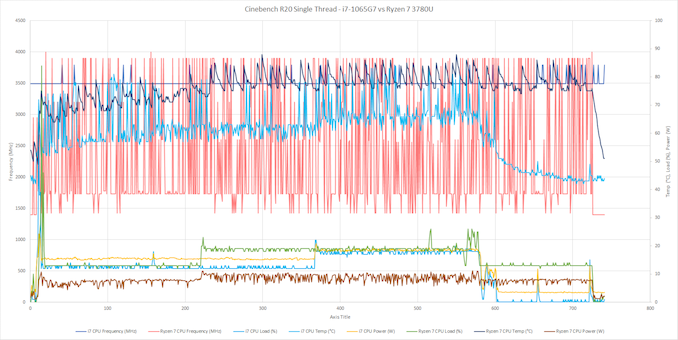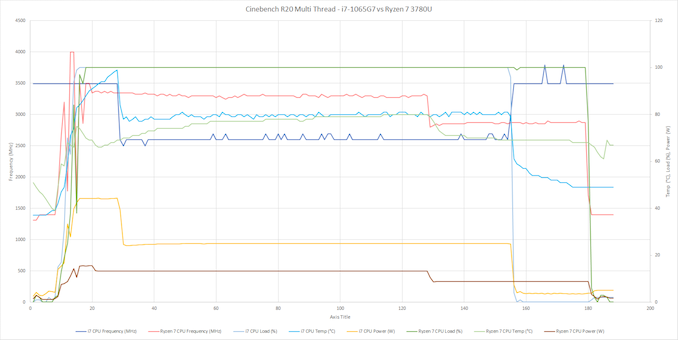The Microsoft Surface Laptop 3 Showdown: AMD's Ryzen Picasso vs. Intel's Ice Lake
by Brett Howse & Andrei Frumusanu on December 13, 2019 8:30 AM ESTBenchmark Analysis: Boost Behavior
Let’s dig into some of the testing to see how the systems responded during the benchmarks. We re-ran several of the tests while simultaneously monitoring the processor frequency, temperature, and power. Unfortunately for our comparison, the power polling results provided by our monitoring tools don’t seem to monitor the same power draw. The Intel power numbers are for the SoC package, but the AMD power numbers appear to be just the CPU cores, which is an unfortunate byproduct of testing two different platforms.
PCMark 10
PCMark 10 is a benchmark platform that attempts to simulate real-world tasks by running a variety of workflow, and the results were perhaps the most interesting of any of the benchmarks. There is a major discrepancy in how the AMD CPU behaved compared to the Intel. The Ice Lake platform kept the CPU frequency at a minimum of 3.5 GHz, with bursts to 3.9 GHz when under load. The Picasso processor was very aggressively switching from low frequency to high frequency, and was rarely indicating that it was over 3.0 GHz, but clearly demonstrating its higher peak frequency of 4.0 GHz in several locations. Both systems were fairly even in terms of CPU temperature, and Intel’s aggressive turbo levels were evident with peak power levels of 40 Watts for brief moments. The Ice Lake platform finished the benchmark about 200 seconds quicker than the Picasso system.
Cinebench R20 Single-Thread
We see somewhat similar results when only a single CPU core is loaded with the Picasso CPU frequency varying quite a bit. There’s also an average higher temperature on the AMD platform during this workload, and once again Ice Lake finishes the rendering quite a bit sooner thanks to its stronger CPU cores.
Cinebench R20 Multi-Thread
With all cores loaded the graph is considerably altered. Here the AMD processor is able to maintain a much higher frequency across its cores for much longer, while Intel's chip is only able to maintain 3.5 GHz for about 30 seconds before it runs out of headroom, dropping the cores down to around 2.6 GHz. But despite the lower frequency, the much higher IPC on Sunny Cove allows the Ice Lake platform to finish quite a bit sooner.













174 Comments
View All Comments
lmcd - Friday, December 13, 2019 - link
There was a window where Intel was still mostly shipping dual-core i5s while AMD shipped the 2500U and 2700U for around the same price. Made for an interesting situation where the AMD units were effectively light-weight desktop replacements, while the Intel units served as ultralights, all while theoretically serving the same market.Point being, there already was a moment where AMD laptop recommendations have made sense.
Also worth noting that Intel's H-series laptops would be a great place for AMD to compete. I'm still unconvinced AMD's core design scales down that well, and afaik Ryzen Mobile still uses the desktop process nodes? So this might be an area where Intel still has a manufacturing advantage -- midrange power consumption.
Teckk - Friday, December 13, 2019 - link
Yes. Need more wins with HP and Dell, something like XPS. Not happening till mobile Zen2 at the very least.nathanddrews - Friday, December 13, 2019 - link
Ice Lake + G7 is giving me flashbacks to the Pentium M/Yonah era buzz.strahinja78 - Friday, December 13, 2019 - link
yeah,...and that wouldn't be good for AMDGreenReaper - Friday, December 13, 2019 - link
They need Zen 2 out on mobile. It'd sort at least half of the performance issues. Better memory would help there, on power, and with graphics as well.MBarton - Monday, December 30, 2019 - link
Zen 2 mobile is a low priority when server and HPDT have much higher margins. AMD needs to offer something competitive when they can afford to, but their margins is key to their financial recovery. Semi-custom CPU's for consoles are low margin, but at least in that case the volumes are so high and they're gaining a potential advantage in gaming by pushing game developers to optimize for RDNA.nathanddrews - Friday, December 13, 2019 - link
But it would be good for the consumer to get some serious computing power with energy efficiency in the mobile space that has otherwise been stagnant for a while.HStewart - Saturday, December 14, 2019 - link
The current Lice likes are consider lower watt models and replacements for higher end IceLake are probably in early 2020 - likely 6 and 8 core models and higher end GPU's.Not intended as gaming CPU's
Korguz - Sunday, December 15, 2019 - link
" higher end IceLake are probably in early 2020 - likely 6 and 8 core models and higher end GPU's. " um yea ok Hstewart, and you have proof of this how ?? my guess. you dont and this is just more of your pro intel opinions.HStewart - Friday, December 20, 2019 - link
Well it just base on Intel road maps with 10nm - it might not be Ice Lake and could be next version. There is no difference in this than people saying wait for Zen 3. So do you expect that Intel will be always on 14nm and current processor will only be on 10nm. Intel has expected roadmaps on 7nm and even far less, I believe and it just a feeling that this battle with chip size will be over next year. Just remember what Intel did during the Pentum 4 days with Frequency wars especial with Intel came out with I series. Until the Zen came out Intel was really look like a monopoly but in reality it is not just AMD was doing so poorly But AMD did Intel a blessing, competition helps company from being lazy and ineffectiveBut I just and older profession who send technology from the early days including original IBM PC with Intel 8088 cpu.